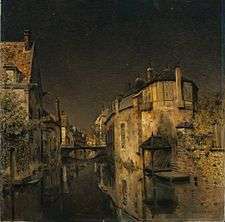Jean-Charles Cazin

Jean-Charles Cazin (May 25, 1840 – March 17, 1901) was a French landscape painter and ceramicist.
Biography
The son of a well-known doctor, FJ Cazin (1788–1864), he was born at Samer, Pas-de-Calais.[1] After studying in France, he went to England, where he was strongly influenced by the pre-Raphaelite movement. His chief earlier pictures have a religious interest, shown in such examples as The Flight into Egypt (1877), or Hagar and Ishmael (1880, Luxembourg); and afterwards his combination of luminous landscape with figure-subjects (Souvenir de fête, 1881; Journée faite, 1888) gave him a wide repute, and made him the leader of a new school of idealistic subject-painting in France.
In 1890, Theodore Child discussed a few of his paintings (including a series of five paintings depicting the story of Judith and Holofernes) in Harper's Magazine.[2] He painted a scene from The Odyssey, Ulysses after the Shipwreck.
He was made an officer of the Legion of Honour in 1889. His charming and poetical treatment of landscape is the feature in his tonalism painting which in later years has given them an increasing value among connoisseurs. His wife, Marie Cazin (1844–1924), who was his pupil and exhibited her first picture at the Salon in 1876, the same year in which Cazin himself made his debut there, was also a well-known artist and sculptor.
See also
References
- ↑ Renoir Fine Art biography
- ↑ Child, Theodore (May 1890). "Some Modern French Painters". Harper's Magazine. pp. 817–42. Retrieved 2009-09-09.
![]() This article incorporates text from a publication now in the public domain: Chisholm, Hugh, ed. (1911). "Cazin, Jean Charles". Encyclopædia Britannica (11th ed.). Cambridge University Press.
This article incorporates text from a publication now in the public domain: Chisholm, Hugh, ed. (1911). "Cazin, Jean Charles". Encyclopædia Britannica (11th ed.). Cambridge University Press.
External links
 Media related to Jean-Charles Cazin at Wikimedia Commons
Media related to Jean-Charles Cazin at Wikimedia Commons- Works by or about Jean-Charles Cazin at Internet Archive
- A Harmony of Color (Rehs Galleries, Inc. biography and images)